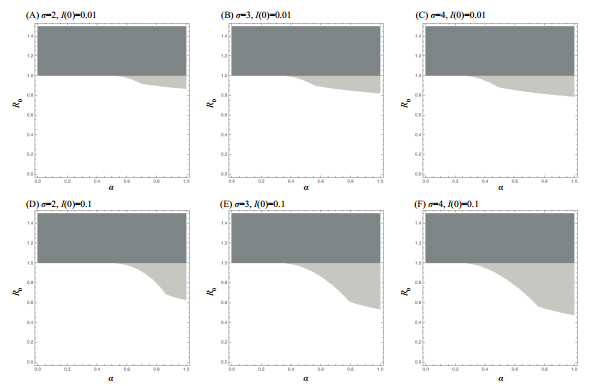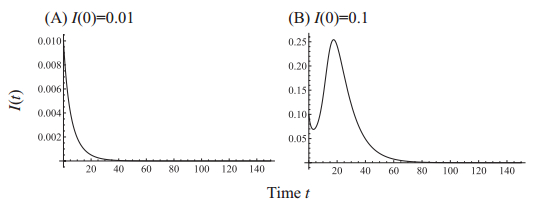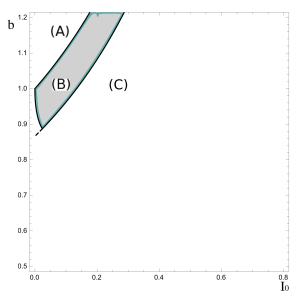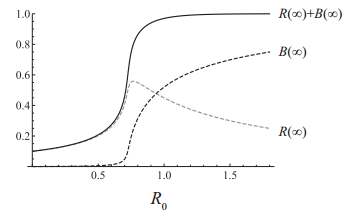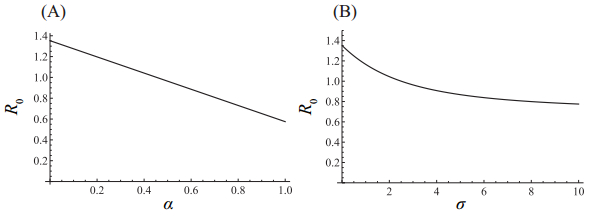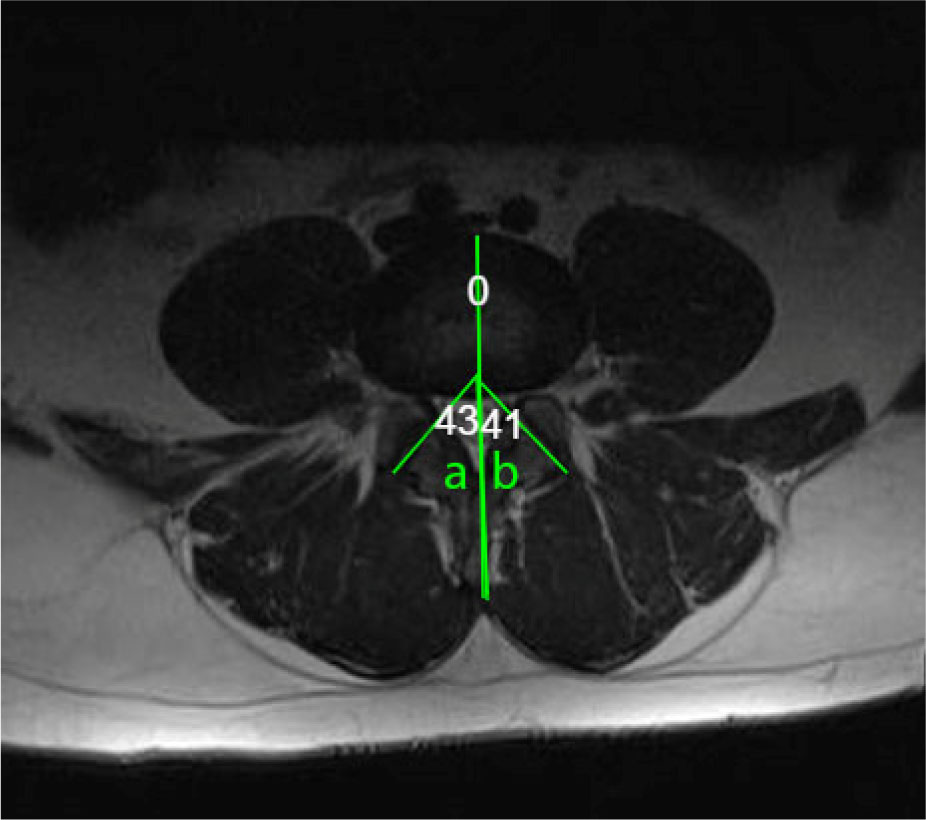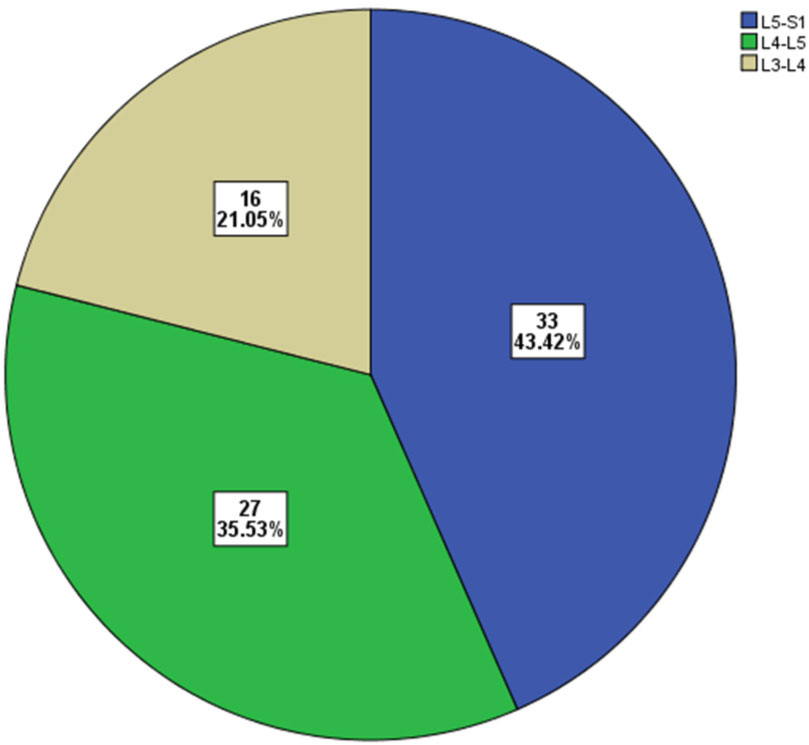| 1.
|
Pei-Yu Liu, Sha He, Li-Bin Rong, San-Yi Tang,
The effect of control measures on COVID-19 transmission in Italy: Comparison with Guangdong province in China,
2020,
9,
2049-9957,
10.1186/s40249-020-00730-2
|
|
| 2.
|
Debadatta Adak, Abhijit Majumder, Nandadulal Bairagi,
Mathematical perspective of Covid-19 pandemic: Disease extinction criteria in deterministic and stochastic models,
2021,
142,
09600779,
110381,
10.1016/j.chaos.2020.110381
|
|
| 3.
|
Nao Yamamoto, Bohan Jiang, Haiyan Wang,
Quantifying compliance with COVID-19 mitigation policies in the US: A mathematical modeling study,
2021,
6,
24680427,
503,
10.1016/j.idm.2021.02.004
|
|
| 4.
|
Yongmei Su, Sinuo Liu, Shurui Song, Xiaoke Li, Yongan Ye,
Stability Analysis and Clinic Phenomenon Simulation of a Fractional-Order HBV Infection Model,
2020,
2020,
1076-2787,
1,
10.1155/2020/8864403
|
|
| 5.
|
Virender Singh Panwar, P.S. Sheik Uduman, J.F. Gómez-Aguilar,
Mathematical modeling of coronavirus disease COVID-19 dynamics using CF and ABC non-singular fractional derivatives,
2021,
145,
09600779,
110757,
10.1016/j.chaos.2021.110757
|
|
| 6.
|
Abdelhafid Zeroual, Fouzi Harrou, Abdelkader Dairi, Ying Sun,
Deep learning methods for forecasting COVID-19 time-Series data: A Comparative study,
2020,
140,
09600779,
110121,
10.1016/j.chaos.2020.110121
|
|
| 7.
|
Prasantha Bharathi Dhandapani, Dumitru Baleanu, Jayakumar Thippan, Vinoth Sivakumar,
On stiff, fuzzy IRD-14 day average transmission model of COVID-19 pandemic disease,
2020,
7,
2375-1495,
208,
10.3934/bioeng.2020018
|
|
| 8.
|
Zishuo Yan, Yueheng Lan,
Modeling COVID-19 infection in a confined space,
2020,
101,
0924-090X,
1643,
10.1007/s11071-020-05802-4
|
|
| 9.
|
Ugochinyere Ihuoma Nwosu, Chukwudi Paul Obite,
Modeling Ivory Coast COVID-19 cases: Identification of a high-performance model for utilization,
2021,
20,
22113797,
103763,
10.1016/j.rinp.2020.103763
|
|
| 10.
|
Costas A. Varotsos, Vladimir F. Krapivin, Yong Xue,
Diagnostic model for the society safety under COVID-19 pandemic conditions,
2021,
136,
09257535,
105164,
10.1016/j.ssci.2021.105164
|
|
| 11.
|
Marouane Mahrouf, Adnane Boukhouima, Houssine Zine, El Mehdi Lotfi, Delfim F. M. Torres, Noura Yousfi,
Modeling and Forecasting of COVID-19 Spreading by Delayed Stochastic Differential Equations,
2021,
10,
2075-1680,
18,
10.3390/axioms10010018
|
|
| 12.
|
Shuyun Jiao, Mingzhan Huang,
An SIHR epidemic model of the COVID-19 with general population-size dependent contact rate,
2020,
5,
2473-6988,
6714,
10.3934/math.2020431
|
|
| 13.
|
Sarbaz H. A. Khoshnaw, Rizgar H. Salih, Sadegh Sulaimany, E. Augeraud, M. Banerjee, J.-S. Dhersin, A. d'Onofrio, T. Lipniacki, S. Petrovskii, Chi Tran, A. Veber-Delattre, E. Vergu, V. Volpert,
Mathematical modelling for coronavirus disease (COVID-19) in predicting future behaviours and sensitivity analysis,
2020,
15,
0973-5348,
33,
10.1051/mmnp/2020020
|
|
| 14.
|
Guo-Rong Xing, Ming-Tao Li, Li Li, Gui-Quan Sun,
The Impact of Population Migration on the Spread of COVID-19: A Case Study of Guangdong Province and Hunan Province in China,
2020,
8,
2296-424X,
10.3389/fphy.2020.587483
|
|
| 15.
|
Md. Kamrujjaman, Md. Shahriar Mahmud, Shakil Ahmed, Md. Omar Qayum, Mohammad Morshad Alam, Md Nazmul Hassan, Md Rafiul Islam, Kaniz Fatema Nipa, Ummugul Bulut,
SARS-CoV-2 and Rohingya Refugee Camp, Bangladesh: Uncertainty and How the Government Took Over the Situation,
2021,
10,
2079-7737,
124,
10.3390/biology10020124
|
|
| 16.
|
Chinwendu E. Madubueze, Sambo Dachollom, Isaac Obiajulu Onwubuya,
Controlling the Spread of COVID-19: Optimal Control Analysis,
2020,
2020,
1748-670X,
1,
10.1155/2020/6862516
|
|
| 17.
|
Ayub Ahmed, Bashdar Salam, Mahmud Mohammad, Ali Akgül, Sarbaz H. A. Khoshnaw,
Analysis coronavirus disease (COVID-19) model using numerical approaches and logistic model,
2020,
7,
2375-1495,
130,
10.3934/bioeng.2020013
|
|
| 18.
|
Islam Abdalla Mohamed, Anis Ben Aissa, Loay F. Hussein, Ahmed I. Taloba, Tarak kallel,
A new model for epidemic prediction: COVID-19 in kingdom saudi arabia case study,
2021,
22147853,
10.1016/j.matpr.2021.01.088
|
|
| 19.
|
Nikolaos Yiannakoulias, Catherine E. Slavik, Shelby L. Sturrock, J. Connor Darlington,
Open government data, uncertainty and coronavirus: An infodemiological case study,
2020,
265,
02779536,
113549,
10.1016/j.socscimed.2020.113549
|
|
| 20.
|
I. Neri, L. Gammaitoni,
Role of fluctuations in epidemic resurgence after a lockdown,
2021,
11,
2045-2322,
10.1038/s41598-021-85808-z
|
|
| 21.
|
Elba Raimúndez, Erika Dudkin, Jakob Vanhoefer, Emad Alamoudi, Simon Merkt, Lara Fuhrmann, Fan Bai, Jan Hasenauer,
COVID-19 outbreak in Wuhan demonstrates the limitations of publicly available case numbers for epidemiological modeling,
2021,
34,
17554365,
100439,
10.1016/j.epidem.2021.100439
|
|
| 22.
|
Sarbaz H.A. Khoshnaw, Muhammad Shahzad, Mehboob Ali, Faisal Sultan,
A quantitative and qualitative analysis of the COVID–19 pandemic model,
2020,
138,
09600779,
109932,
10.1016/j.chaos.2020.109932
|
|
| 23.
|
Agrim Subedi, Madhav Raj Pandey, Sahadev Bistha, Catalino Dotollo Jr., Feliciano Jonh Matibag Jr., Lok Raj Poudel, Krishna Prasad Subedi,
Impact of Solar Planet on Coronavirus (COVID-19) Outbreak,
2020,
2395-602X,
425,
10.32628/IJSRST207646
|
|
| 24.
|
J.E. Macías-Díaz, Ali Raza, Nauman Ahmed, Muhammad Rafiq,
Analysis of a nonstandard computer method to simulate a nonlinear stochastic epidemiological model of coronavirus-like diseases,
2021,
01692607,
106054,
10.1016/j.cmpb.2021.106054
|
|
| 25.
|
James Francis Oehmke, Charles B Moss, Lauren Nadya Singh, Theresa Bristol Oehmke, Lori Ann Post,
Dynamic Panel Surveillance of COVID-19 Transmission in the United States to Inform Health Policy: Observational Statistical Study,
2020,
22,
1438-8871,
e21955,
10.2196/21955
|
|
| 26.
|
Csaba Farkas, David Iclanzan, Boróka Olteán-Péter, Géza Vekov,
Estimation of parameters for a humidity-dependent compartmental model of the COVID-19 outbreak,
2021,
9,
2167-8359,
e10790,
10.7717/peerj.10790
|
|
| 27.
|
Benjamin Wacker, Jan Schlüter,
Time-continuous and time-discrete SIR models revisited: theory and applications,
2020,
2020,
1687-1847,
10.1186/s13662-020-02995-1
|
|
| 28.
|
Dipo Aldila,
Analyzing the impact of the media campaign and rapid testing for COVID-19 as an optimal control problem in East Java, Indonesia,
2020,
141,
09600779,
110364,
10.1016/j.chaos.2020.110364
|
|
| 29.
|
Abhijit Majumder, Debadatta Adak, Nandadulal Bairagi,
Persistence and extinction criteria of Covid-19 pandemic: India as a case study,
2021,
0736-2994,
1,
10.1080/07362994.2021.1894172
|
|
| 30.
|
Costas A. Varotsos, Vladimir F. Krapivin,
A new model for the spread of COVID-19 and the improvement of safety,
2020,
132,
09257535,
104962,
10.1016/j.ssci.2020.104962
|
|
| 31.
|
Saad Awadh Alanazi, M. M. Kamruzzaman, Madallah Alruwaili, Nasser Alshammari, Salman Ali Alqahtani, Ali Karime, Dilbag Singh,
Measuring and Preventing COVID-19 Using the SIR Model and Machine Learning in Smart Health Care,
2020,
2020,
2040-2309,
1,
10.1155/2020/8857346
|
|
| 32.
|
Michał Wieczorek, Jakub Siłka, Marcin Woźniak,
Neural network powered COVID-19 spread forecasting model,
2020,
140,
09600779,
110203,
10.1016/j.chaos.2020.110203
|
|
| 33.
|
N.H. Sweilam, S.M. AL - Mekhlafi, D. Baleanu,
A hybrid stochastic fractional order Coronavirus (2019-nCov) mathematical model,
2021,
145,
09600779,
110762,
10.1016/j.chaos.2021.110762
|
|
| 34.
|
Nitin K Kamboj, Sangeeta Sharma, Sandeep Sharma,
2021,
Chapter 16,
978-981-33-6263-5,
309,
10.1007/978-981-33-6264-2_16
|
|
| 35.
|
S. Ibrahim-Tiamiyu, O. V. Oni, E. O. Adeleke,
Markovian Analysis of Covid-19 Dynamics,
2021,
4,
2689-5323,
94,
10.52589/ajmss_fzzq3wga
|
|
| 36.
|
Hanna Wulkow, Tim O. F. Conrad, Nataša Djurdjevac Conrad, Sebastian A. Müller, Kai Nagel, Christof Schütte, Seyedali Mirjalili,
Prediction of Covid-19 spreading and optimal coordination of counter-measures: From microscopic to macroscopic models to Pareto fronts,
2021,
16,
1932-6203,
e0249676,
10.1371/journal.pone.0249676
|
|
| 37.
|
J. Đorđević, I. Papić, N. Šuvak,
A two diffusion stochastic model for the spread of the new corona virus SARS-CoV-2,
2021,
09600779,
110991,
10.1016/j.chaos.2021.110991
|
|
| 38.
|
Ruqi Li, Yurong Song, Haiyan Wang, Guo-Ping Jiang, Min Xiao,
Reactive–diffusion epidemic model on human mobility networks: Analysis and applications to COVID-19 in China,
2023,
609,
03784371,
128337,
10.1016/j.physa.2022.128337
|
|
| 39.
|
Omaji Samuel, Akogwu Blessing Omojo, Abdulkarim Musa Onuja, Yunisa Sunday, Prayag Tiwari, Deepak Gupta, Ghulam Hafeez, Adamu Sani Yahaya, Oluwaseun Jumoke Fatoba, Shahab Shamshirband,
IoMT: A COVID-19 Healthcare System Driven by Federated Learning and Blockchain,
2023,
27,
2168-2194,
823,
10.1109/JBHI.2022.3143576
|
|
| 40.
|
Abdon Atangana, Seda İgret Araz,
2022,
Chapter 6,
978-981-19-0728-9,
131,
10.1007/978-981-19-0729-6_6
|
|
| 41.
|
M. Aykut Attar, Ayça Tekin-Koru,
Latent social distancing: Identification, causes and consequences,
2022,
46,
09393625,
100944,
10.1016/j.ecosys.2022.100944
|
|
| 42.
|
Tiri Chinyoka,
Stochastic modelling of the dynamics of infections caused by the SARS-CoV-2 and COVID-19 under various conditions of lockdown, quarantine, and testing,
2021,
28,
22113797,
104573,
10.1016/j.rinp.2021.104573
|
|
| 43.
|
Vanshika Aggarwal, Geeta Arora, Homan Emadifar, Faraidun K. Hamasalh, Masoumeh Khademi, Sania Qureshi,
Numerical Simulation to Predict COVID-19 Cases in Punjab,
2022,
2022,
1748-6718,
1,
10.1155/2022/7546393
|
|
| 44.
|
Noureddine Ouerfelli, Narcisa Vrinceanu, Diana Coman, Adriana Lavinia Cioca,
Empirical Modeling of COVID-19 Evolution with High/Direct Impact on Public Health and Risk Assessment,
2022,
19,
1660-4601,
3707,
10.3390/ijerph19063707
|
|
| 45.
|
Huili Wei, Wenhe Li,
Dynamical behaviors of a Lotka-Volterra competition system with the Ornstein-Uhlenbeck process,
2023,
20,
1551-0018,
7882,
10.3934/mbe.2023341
|
|
| 46.
|
Zhenfeng Shi, Daqing Jiang, Xinhong Zhang, Ahmed Alsaedi,
A stochastic SEIRS rabies model with population dispersal: Stationary distribution and probability density function,
2022,
427,
00963003,
127189,
10.1016/j.amc.2022.127189
|
|
| 47.
|
W. Ahmad, M. Abbas, M. Rafiq, D. Baleanu,
Mathematical analysis for the effect of voluntary vaccination on the propagation of Corona virus pandemic,
2021,
31,
22113797,
104917,
10.1016/j.rinp.2021.104917
|
|
| 48.
|
Ajay Kumar, Tsan-Ming Choi, Samuel Fosso Wamba, Shivam Gupta, Kim Hua Tan,
Infection vulnerability stratification risk modelling of COVID-19 data: a deterministic SEIR epidemic model analysis,
2021,
0254-5330,
10.1007/s10479-021-04091-3
|
|
| 49.
|
Abdon Atangana, Seda İgret Araz,
2022,
Chapter 8,
978-981-19-0728-9,
237,
10.1007/978-981-19-0729-6_8
|
|
| 50.
|
Shehzad Afzal, Sohaib Ghani, Hank C. Jenkins-Smith, David S. Ebert, Markus Hadwiger, Ibrahim Hoteit,
2020,
A Visual Analytics Based Decision Making Environment for COVID-19 Modeling and Visualization,
978-1-7281-8014-4,
86,
10.1109/VIS47514.2020.00024
|
|
| 51.
|
Abdon Atangana, Seda İgret Araz,
2022,
Chapter 11,
978-981-19-0728-9,
423,
10.1007/978-981-19-0729-6_11
|
|
| 52.
|
Xueying Wang, Sunpeng Wang, Jin Wang, Libin Rong,
A Multiscale Model of COVID-19 Dynamics,
2022,
84,
0092-8240,
10.1007/s11538-022-01058-8
|
|
| 53.
|
André Vinícius Gonçalves, Ione Jayce Ceola Schneider, Fernanda Vargas Amaral, Leandro Pereira Garcia, Gustavo Medeiros de Araújo,
2021,
Chapter 20,
978-3-030-77416-5,
272,
10.1007/978-3-030-77417-2_20
|
|
| 54.
|
Bo Yang, Zhenhua Yu, Yuanli Cai,
A spread model of COVID-19 with some strict anti-epidemic measures,
2022,
109,
0924-090X,
265,
10.1007/s11071-022-07244-6
|
|
| 55.
|
Wojciech Wróblewski, Norbert Tuśnio, Paweł Wolny, Dorota Siuta, Janusz Trzebicki, Teresa Bączkowska, Olga Dzikowska-Diduch, Piotr Pruszczyk,
Fire Safety of Healthcare Units in Conditions of Oxygen Therapy in COVID-19: Empirical Establishing of Effects of Elevated Oxygen Concentrations,
2022,
14,
2071-1050,
4315,
10.3390/su14074315
|
|
| 56.
|
Tailei Zhang, Zhimin Li,
Analysis of COVID-19 epidemic transmission trend based on a time-delayed dynamic model,
2023,
22,
1534-0392,
1,
10.3934/cpaa.2021088
|
|
| 57.
|
Leonardo S. Lima,
Dynamics based on analysis of public data for spreading of disease,
2021,
11,
2045-2322,
10.1038/s41598-021-91024-6
|
|
| 58.
|
Haoran Fan,
2021,
Research on Clinical Treatment of Biomedicine in Preventing Epidemic Model,
9781450385077,
94,
10.1145/3502871.3502887
|
|
| 59.
|
Sha He, Jie Yang, Mengqi He, Dingding Yan, Sanyi Tang, Libin Rong,
The risk of future waves of COVID-19: modeling and data analysis,
2021,
18,
1551-0018,
5409,
10.3934/mbe.2021274
|
|
| 60.
|
Eiman Ijaz, Johar Ali, Abbas Khan, Muhammad Shafiq, Taj Munir,
2023,
Chapter 9,
978-1-80356-566-8,
10.5772/intechopen.108450
|
|
| 61.
|
Yuansan Liu, Saransh Srivastava, Zuo Huang, Felisa J. Vázquez-Abad,
Pandemic model with data-driven phase detection, a study using COVID-19 data,
2021,
0160-5682,
1,
10.1080/01605682.2021.1982652
|
|
| 62.
|
Roman Zúñiga Macías, Humberto Gutiérrez-Pulido, Edgar Alejandro Guerrero Arroyo, Abel Palafox González,
Geographical network model for COVID-19 spread among dynamic epidemic regions,
2022,
19,
1551-0018,
4237,
10.3934/mbe.2022196
|
|
| 63.
|
Abdon Atangana, Seda İgret Araz,
2022,
Chapter 10,
978-981-19-0728-9,
353,
10.1007/978-981-19-0729-6_10
|
|
| 64.
|
Supriya Vanahalli, Preethi N,
2021,
An Intelligent System to Forecast COVID-19 Pandemic using Hybrid Neural Network,
978-1-6654-2306-9,
543,
10.1109/CSNT51715.2021.9509622
|
|
| 65.
|
Tarun Kumar Martheswaran, Hamida Hamdi, Amal Al-Barty, Abeer Abu Zaid, Biswadeep Das,
Prediction of dengue fever outbreaks using climate variability and Markov chain Monte Carlo techniques in a stochastic susceptible-infected-removed model,
2022,
12,
2045-2322,
10.1038/s41598-022-09489-y
|
|
| 66.
|
Abdulaziz Attaallah, Sabita Khatri, Mohd Nadeem, Syed Anas Ansar, Abhishek Kumar Pandey, Alka Agrawal,
Prediction of COVID-19 Pandemic Spread in Kingdom of Saudi Arabia,
2021,
37,
0267-6192,
313,
10.32604/csse.2021.014933
|
|
| 67.
|
Mihaela Cornelia Dan, Simona Irina Goia, Vlad I. Roşca,
2022,
Chapter 11,
978-3-030-82754-0,
189,
10.1007/978-3-030-82755-7_11
|
|
| 68.
|
Martijn H. H. Schoot Uiterkamp, Martijn Gösgens, Hans Heesterbeek, Remco van der Hofstad, Nelly Litvak,
The role of inter-regional mobility in forecasting SARS-CoV-2 transmission,
2022,
19,
1742-5662,
10.1098/rsif.2022.0486
|
|
| 69.
|
Yansong Pei, Bing Liu, Haokun Qi,
Extinction and stationary distribution of stochastic predator-prey model with group defense behavior,
2022,
19,
1551-0018,
13062,
10.3934/mbe.2022610
|
|
| 70.
|
Feres A. Salem, Ubirajara F. Moreno,
A Multi-Agent-Based Simulation Model for the Spreading of Diseases Through Social Interactions During Pandemics,
2022,
33,
2195-3880,
1161,
10.1007/s40313-022-00920-3
|
|
| 71.
|
Abdon Atangana, Seda İgret Araz,
2022,
Chapter 9,
978-981-19-0728-9,
275,
10.1007/978-981-19-0729-6_9
|
|
| 72.
|
Carla Marcelino Trassante, Victor dos Santos Barboza, Liziane dos Santos Rocha, Paulo Maximiliano Correa, Cristiane Luchese, Ethel Antunes Wilhelm, Claudio Martin Pereira de Pereira, Matheus Dellaméa Baldissera, Virginia Cielo Rech, Janice Luehring Giongo, Rodrigo de Almeida Vaucher,
Detection of SARS-CoV-2 virus using an alternative molecular method and evaluation of biochemical, hematological, inflammatory, and oxidative stress in healthcare professionals,
2021,
158,
08824010,
104975,
10.1016/j.micpath.2021.104975
|
|
| 73.
|
Manal El Mouhib, Kamal Azghiou, Abdelhamid Benali,
2022,
Connected and Autonomous Vehicles against a Malware Spread : A Stochastic Modeling Approach,
978-1-6654-8684-2,
1,
10.1109/IEMTRONICS55184.2022.9795713
|
|
| 74.
|
Seung-Nam Park, Hyong-Ha Kim, Kyoung Beom Lee,
Inherently high uncertainty in predicting the time evolution of epidemics,
2021,
43,
2092-7193,
e2021014,
10.4178/epih.e2021014
|
|
| 75.
|
Shahriar Seddighi Chaharborj, Sarkhosh Seddighi Chaharborj, Jalal Hassanzadeh Asl, Pei See Phang,
Controlling of pandemic COVID-19 using optimal control theory,
2021,
26,
22113797,
104311,
10.1016/j.rinp.2021.104311
|
|
| 76.
|
Xiao-Li Ding, Iván Area, Juan J. Nieto,
Controlled singular evolution equations and Pontryagin type maximum principle with applications,
2022,
11,
2163-2480,
1655,
10.3934/eect.2021059
|
|
| 77.
|
Amir Veisi, Hadi Delavari,
A novel fractional-order feedback management of COVID-19 prevalence,
2022,
25,
0972-0510,
1345,
10.1080/09720510.2021.1970951
|
|
| 78.
|
Junaid Iqbal Khan, Jebran Khan, Furqan Ali, Farman Ullah, Jamshid Bacha, Sungchang Lee,
Artificial Intelligence and Internet of Things (AI-IoT) Technologies in Response to COVID-19 Pandemic: A Systematic Review,
2022,
10,
2169-3536,
62613,
10.1109/ACCESS.2022.3181605
|
|
| 79.
|
Divine Wanduku,
The multilevel hierarchical data EM-algorithm. Applications to discrete-time Markov chain epidemic models,
2022,
8,
24058440,
e12622,
10.1016/j.heliyon.2022.e12622
|
|
| 80.
|
Xiaoying Wang, Qing Han, Jude Dzevela Kong,
Studying the mixed transmission in a community with age heterogeneity: COVID-19 as a case study,
2022,
7,
24680427,
250,
10.1016/j.idm.2022.05.006
|
|
| 81.
|
2023,
9780443186790,
229,
10.1016/B978-0-44-318679-0.00013-2
|
|
| 82.
|
Nursanti Anggriani, Lazarus Kalvein Beay,
Modeling of COVID-19 spread with self-isolation at home and hospitalized classes,
2022,
36,
22113797,
105378,
10.1016/j.rinp.2022.105378
|
|
| 83.
|
Leonardo dos Santos Lima,
Fractional Stochastic Differential Equation Approach for Spreading of Diseases,
2022,
24,
1099-4300,
719,
10.3390/e24050719
|
|
| 84.
|
Sahil Ahuja, Nitin Arvind Shelke, Pawan Kumar Singh,
A deep learning framework using CNN and stacked Bi-GRU for COVID-19 predictions in India,
2022,
16,
1863-1703,
579,
10.1007/s11760-021-01988-1
|
|
| 85.
|
Bimal Kumar Mishra,
Stochastic models on the transmission of novel COVID-19,
2022,
13,
0975-6809,
599,
10.1007/s13198-021-01312-7
|
|
| 86.
|
C. Gokila, M. Sambath, K. Balachandran, Yong-Ki Ma,
Stationary distribution and long-time behavior of COVID-19 model with stochastic effect,
2023,
16,
1793-5245,
10.1142/S1793524522500747
|
|
| 87.
|
Roozbeh Abolpour, Sara Siamak, Mohsen Mohammadi, Parisa Moradi, Maryam Dehghani,
Linear parameter varying model of COVID-19 pandemic exploiting basis functions,
2021,
70,
17468094,
102999,
10.1016/j.bspc.2021.102999
|
|
| 88.
|
Kexin Chen, Chi Seng Pun, Hoi Ying Wong,
Efficient social distancing during the COVID-19 pandemic: Integrating economic and public health considerations,
2023,
304,
03772217,
84,
10.1016/j.ejor.2021.11.012
|
|
| 89.
|
Sultanah M. Alshammari, Waleed K. Almutiry, Harsha Gwalani, Saeed M. Algarni, Kawther Saeedi,
Measuring the impact of suspending Umrah, a global mass gathering in Saudi Arabia on the COVID-19 pandemic,
2021,
1381-298X,
10.1007/s10588-021-09343-y
|
|
| 90.
|
Sewanou H. Honfo, Hemaho B. Taboe, Romain Glèlè Kakaï,
Modeling COVID-19 dynamics in the sixteen West African countries,
2022,
18,
24682276,
e01408,
10.1016/j.sciaf.2022.e01408
|
|
| 91.
|
Natasha Sharma, Atul Kumar Verma, Arvind Kumar Gupta,
Spatial network based model forecasting transmission and control of COVID-19,
2021,
581,
03784371,
126223,
10.1016/j.physa.2021.126223
|
|
| 92.
|
Enes Eryarsoy, Masoud Shahmanzari, Fehmi Tanrisever,
Models for government intervention during a pandemic,
2023,
304,
03772217,
69,
10.1016/j.ejor.2021.12.036
|
|
| 93.
|
Aaqib Inam, Ayesha Sarwar, Ayesha Atta, Iftikhar Naaseer, Shahan Yamin Siddiqui, Muhammad Adnan Khan,
Detection of COVID-19 Enhanced by a Deep Extreme Learning Machine,
2021,
27,
1079-8587,
701,
10.32604/iasc.2021.014235
|
|
| 94.
|
A. Mhlanga, T. V. Mupedza,
A patchy theoretical model for the transmission dynamics of SARS-Cov-2 with optimal control,
2022,
12,
2045-2322,
10.1038/s41598-022-21553-1
|
|
| 95.
|
P. Renukadevi, A. Rajiv Kannan,
Covid-19 Forecasting with Deep Learning-based Half-binomial Distribution Cat Swarm Optimization,
2023,
44,
0267-6192,
629,
10.32604/csse.2023.024217
|
|
| 96.
|
Sanmitra Ghosh, Saptarshi Chatterjee, Shatarupa Biswas, Megha Dutta,
2022,
9780323858441,
97,
10.1016/B978-0-323-85844-1.00010-6
|
|
| 97.
|
Demián García-Violini, Ricardo Sánchez-Peña, Marcela Moscoso-Vásquez, Fabricio Garelli,
Non-pharmaceutical intervention to reduce COVID-19 impact in Argentina,
2022,
124,
00190578,
225,
10.1016/j.isatra.2021.06.024
|
|
| 98.
|
Ayman Mourad, Fatima Mroue, Zahraa Taha,
Stochastic mathematical models for the spread of COVID-19: a novel epidemiological approach,
2022,
39,
1477-8599,
49,
10.1093/imammb/dqab019
|
|
| 99.
|
Cheng-Cheng Zhu, Jiang Zhu,
Spread trend of COVID-19 epidemic outbreak in China: using exponential attractor method in a spatial heterogeneous SEIQR model,
2020,
17,
1551-0018,
3062,
10.3934/mbe.2020174
|
|
| 100.
|
Aysan Vaez, Amin Izadi, Majid Mirmohammadkhani, Mohammad Memarian, Maral Hemati, Parviz Kokhaei,
Infectivity Period After Symptom Relief in SARS-CoV-2 Patients: An Experimental Trial,
2022,
9,
2423-4451,
10.5812/mejrh.115349
|
|
| 101.
|
William Qian, Sanjukta Bhowmick, Marty O’Neill, Suhasini Ramisetty-Mikler, Armin R. Mikler,
Applying a Probabilistic Infection Model for studying contagion processes in contact networks,
2021,
54,
18777503,
101419,
10.1016/j.jocs.2021.101419
|
|
| 102.
|
Jingli Ren, Haiyan Wang,
2023,
9780443186790,
173,
10.1016/B978-0-44-318679-0.00012-0
|
|
| 103.
|
Adesoye Idowu Abioye, Olumuyiwa James Peter, Hammed Abiodun Ogunseye, Festus Abiodun Oguntolu, Kayode Oshinubi, Abdullahi Adinoyi Ibrahim, Ilyas Khan,
Mathematical model of COVID-19 in Nigeria with optimal control,
2021,
28,
22113797,
104598,
10.1016/j.rinp.2021.104598
|
|
| 104.
|
Wenhui Zhu, Jie Feng, Cheng Li, Huimin Wang, Yang Zhong, Lijun Zhou, Xingyu Zhang, Tao Zhang,
COVID-19 Risk Assessment for the Tokyo Olympic Games,
2021,
9,
2296-2565,
10.3389/fpubh.2021.730611
|
|
| 105.
|
Jin Guo, Aili Wang, Weike Zhou, Yinjiao Gong, Stacey R. Smith?,
Discrete epidemic modelling of COVID-19 transmission in Shaanxi Province with media reporting and imported cases,
2021,
19,
1551-0018,
1388,
10.3934/mbe.2022064
|
|
| 106.
|
A.I.K. Butt, W. Ahmad, M. Rafiq, D. Baleanu,
Numerical analysis of Atangana-Baleanu fractional model to understand the propagation of a novel corona virus pandemic,
2022,
61,
11100168,
7007,
10.1016/j.aej.2021.12.042
|
|
| 107.
|
Abdon Atangana, Seda İgret Araz,
2022,
Chapter 12,
978-981-19-0728-9,
481,
10.1007/978-981-19-0729-6_12
|
|
| 108.
|
Mathilde Massard, Raluca Eftimie, Antoine Perasso, Bruno Saussereau,
A multi-strain epidemic model for COVID-19 with infected and asymptomatic cases: Application to French data,
2022,
545,
00225193,
111117,
10.1016/j.jtbi.2022.111117
|
|
| 109.
|
Kazem Nouri, Milad Fahimi, Leila Torkzadeh, Dumitru Baleanu,
Stochastic Epidemic Model of Covid-19 via the Reservoir-People Transmission Network,
2022,
72,
1546-2226,
1495,
10.32604/cmc.2022.024406
|
|
| 110.
|
Fran Sérgio Lobato, Gustavo Barbosa Libotte, Gustavo Mendes Platt,
Mathematical modelling of the second wave of COVID-19 infections using deterministic and stochastic SIDR models,
2021,
106,
0924-090X,
1359,
10.1007/s11071-021-06680-0
|
|
| 111.
|
D. Nagarajan, R. Sujatha, G. Kuppuswami, J. Kavikumar,
Real-time forecasting of the COVID 19 using fuzzy grey Markov: a different approach in decision-making,
2022,
41,
2238-3603,
10.1007/s40314-022-01949-5
|
|
| 112.
|
Chuang Xu, Yongzhen Pei, Shengqiang Liu, Jinzhi Lei,
Effectiveness of non-pharmaceutical interventions against local transmission of COVID-19: An individual-based modelling study,
2021,
6,
24680427,
848,
10.1016/j.idm.2021.06.005
|
|
| 113.
|
Wenjing Zhao, Lin Zhang, Junling Wang, Lili Wang,
How has academia responded to the urgent needs created by COVID-19? A multi-level global, regional and national analysis,
2022,
0165-5515,
016555152210846,
10.1177/01655515221084646
|
|
| 114.
|
Christiana Tsiligianni, Aristeides Tsiligiannis, Christos Tsiliyannis,
A stochastic inventory model of COVID-19 and robust, real-time identification of carriers at large and infection rate via asymptotic laws,
2023,
304,
03772217,
42,
10.1016/j.ejor.2021.12.037
|
|
| 115.
|
Xinyu Bai, Shaojuan Ma,
Stochastic dynamical behavior of COVID-19 model based on secondary vaccination,
2022,
20,
1551-0018,
2980,
10.3934/mbe.2023141
|
|
| 116.
|
S Zenian,
The SIR Model for COVID-19 in Malaysia,
2022,
2314,
1742-6588,
012007,
10.1088/1742-6596/2314/1/012007
|
|
| 117.
|
Ru-Qi Li, Yu-Rong Song, Guo-Ping Jiang,
Prediction of epidemics dynamics on networks with partial differential equations: A case study for COVID-19 in China*
,
2021,
30,
1674-1056,
120202,
10.1088/1674-1056/ac2b16
|
|
| 118.
|
Cunjuan Dong, Changcheng Xiang, Wenjin Qin, Yi Yang,
Global dynamics for a Filippov system with media effects,
2022,
19,
1551-0018,
2835,
10.3934/mbe.2022130
|
|
| 119.
|
André Vinícius Gonçalves, Gustavo Medeiros de Araujo, Leandro Pereira Garcia, Fernanda Vargas Amaral, Ione Jayce Ceola Schneider,
Feature Importance Analysis by Nowcasting Perspective to Predict COVID-19,
2022,
27,
1383-469X,
1967,
10.1007/s11036-022-01966-y
|
|
| 120.
|
Farid A. Badria,
2022,
Chapter 2,
978-1-80355-330-6,
10.5772/intechopen.103153
|
|
| 121.
|
A. M. Elshehawey, Zhengming Qian,
A novel high-order multivariate Markov model for spatiotemporal analysis with application to COVID-19 outbreak,
2023,
52,
1226-3192,
495,
10.1007/s42952-023-00210-x
|
|
| 122.
|
Wenxuan Li, Suli Liu,
Dynamic analysis of a stochastic epidemic model incorporating the double epidemic hypothesis and Crowley-Martin incidence term,
2023,
31,
2688-1594,
6134,
10.3934/era.2023312
|
|
| 123.
|
Costas A. Varotsos, Vladimir F. Krapivin, Ferdenant A. Mkrtchyan, Yong Xue,
2023,
Chapter 2,
978-3-031-28876-0,
119,
10.1007/978-3-031-28877-7_2
|
|
| 124.
|
Mirna Patricia Ponce-Flores, Jesús David Terán-Villanueva, Salvador Ibarra-Martínez, José Antonio Castán-Rocha,
Generalized Pandemic Model with COVID-19 for Early-Stage Infection Forecasting,
2023,
11,
2227-7390,
3924,
10.3390/math11183924
|
|
| 125.
|
Costas A. Varotsos, Vladimir F. Krapivin, Ferdenant A. Mkrtchyan, Yong Xue,
2023,
Chapter 3,
978-3-031-28876-0,
163,
10.1007/978-3-031-28877-7_3
|
|
| 126.
|
Mohammed Salman, Prativa Sahoo, Anushaya Mohapatra, Sanjay Kumar Mohanty, Libin Rong,
An infectious disease epidemic model with migration and stochastic transmission in deterministic and stochastic environments,
2024,
5,
27724425,
100337,
10.1016/j.health.2024.100337
|
|
| 127.
|
Yuxiao Zhao, Hui Wang, Dongxu Wang,
The Dynamic Behavior of a Stochastic SEIRM Model of COVID-19 with Standard Incidence Rate,
2024,
12,
2227-7390,
2966,
10.3390/math12192966
|
|
| 128.
|
Niketa Ukaj, Christian Hellmich, Stefan Scheiner,
Aging Epidemiology: A Hereditary Mechanics–Inspired Approach to COVID-19 Fatality Rates,
2024,
150,
0733-9399,
10.1061/JENMDT.EMENG-7640
|
|
| 129.
|
Xiaojie Mu, Daqing Jiang,
A stochastic SIHR epidemic model with general population-size dependent contact rate and Ornstein–Uhlenbeck process: dynamics analysis,
2024,
112,
0924-090X,
10703,
10.1007/s11071-024-09586-9
|
|
| 130.
|
A. Lahrouz, T. Caraballo, I. Bouzalmat, A. Settati,
Randomness suppress backward bifurcation in an epidemic model with limited medical resources,
2025,
140,
10075704,
108380,
10.1016/j.cnsns.2024.108380
|
|
| 131.
|
Denis Ndanguza, Jean Pierre Ngendahayo, Annie Uwimana, Jean de Dieu Niyigena, Isambi S. Mbalawata, Innocent Ngaruye, Joseph Nzabanita, Emmanuel Masabo, Marcel Gahamanyi, Bosco Nyandwi, Justine Dushimirimana, Lydie Mpinganzima, Celestin Kurujyibwami, Leon Fidele Uwimbabazi Ruganzu, Venuste Nyagahakwa, Wellars Banzi, Solange Mukeshimana, Jean Pierre Muhirwa, Jean Paul Nsabimana, Jeanne Uwonkunda, Betty Kivumbi Nannyonga, Japhet Niyobuhungiro, Eric Rutaganda, Jean Marie Ntaganda,
Analysis of the COVID-19 pandemic in Rwanda using a stochastic model,
2024,
03,
2811-0072,
10.1142/S281100722350013X
|
|
| 132.
|
Sida Kang, Tianhao Liu, Hongyu Liu, Yuhan Hu, Xilin Hou, Sanket Kaushik,
Dynamic analysis and optimal control of stochastic information cross-dissemination and variation model with random parametric perturbations,
2024,
19,
1932-6203,
e0303300,
10.1371/journal.pone.0303300
|
|
| 133.
|
Ge Zhang, Zhiming Li, Anwarud Din, Tao Chen,
Dynamic analysis and optimal control of a stochastic COVID-19 model,
2024,
215,
03784754,
498,
10.1016/j.matcom.2023.08.005
|
|
| 134.
|
Qianqian Sun, Dejun Tan, Shuwen Zhang,
Epidemic threshold of a COVID-19 model with gaussian white noise and semi-Markov switching,
2023,
360,
00160032,
6846,
10.1016/j.jfranklin.2023.04.035
|
|
| 135.
|
Costas A. Varotsos, Vladimir F. Krapivin, Ferdenant A. Mkrtchyan, Yong Xue,
2023,
Chapter 6,
978-3-031-28876-0,
293,
10.1007/978-3-031-28877-7_6
|
|
| 136.
|
Daniele Baccega, Paolo Castagno, Antonio Fernández Anta, Matteo Sereno,
Enhancing COVID-19 forecasting precision through the integration of compartmental models, machine learning and variants,
2024,
14,
2045-2322,
10.1038/s41598-024-69660-5
|
|
| 137.
|
Ugo Avila-Ponce de León, Angel G. C. Pérez, Eric Avila-Vales,
Modeling the SARS-CoV-2 Omicron variant dynamics in the United States with booster dose vaccination and waning immunity,
2023,
20,
1551-0018,
10909,
10.3934/mbe.2023484
|
|
| 138.
|
Jie Yang, Sanyi Tang, Jie Lou,
A stochastic discrete-time co-evolution model and its application in simulating the impacts of behavior changes on the secondary and multiple outbreaks of the COVID-19 pandemic,
2023,
138,
2190-5444,
10.1140/epjp/s13360-023-04702-x
|
|
| 139.
|
Xinhong Zhang, Qing Yang, Tan Su,
Dynamical behavior and numerical simulation of a stochastic eco-epidemiological model with Ornstein–Uhlenbeck process,
2023,
123,
10075704,
107284,
10.1016/j.cnsns.2023.107284
|
|
| 140.
|
Christos Tsiliyannis,
Beyond SIRD models: a novel dynamic model for epidemics, relating infected with entries to health care units and application for identification and restraining policy,
2024,
41,
1477-8599,
192,
10.1093/imammb/dqae008
|
|
| 141.
|
Costas A. Varotsos, Vladimir F. Krapivin, Ferdenant A. Mkrtchyan, Yong Xue,
2023,
Chapter 1,
978-3-031-28876-0,
1,
10.1007/978-3-031-28877-7_1
|
|
| 142.
|
Yue Yu, Yuanshun Tan, Sanyi Tang,
Stability analysis of the COVID-19 model with age structure under media effect,
2023,
42,
2238-3603,
10.1007/s40314-023-02330-w
|
|
| 143.
|
Costas A. Varotsos, Vladimir F. Krapivin, Ferdenant A. Mkrtchyan, Yong Xue,
2023,
Chapter 7,
978-3-031-28876-0,
399,
10.1007/978-3-031-28877-7_7
|
|
| 144.
|
Khristo Tarnev, Nikolay K. Vitanov,
2023,
2939,
0094-243X,
090009,
10.1063/5.0178872
|
|
| 145.
|
Henry Egbezien Inegbedion,
A Time Series Forecast of COVID-19 Infections, Recoveries and Fatalities in Nigeria,
2023,
15,
2071-1050,
7324,
10.3390/su15097324
|
|
| 146.
|
Berik Koichubekov, Aliya Takuadina, Ilya Korshukov, Marina Sorokina, Anar Turmukhambetova,
The Epidemiological and Economic Impact of COVID-19 in Kazakhstan: An Agent-Based Modeling,
2023,
11,
2227-9032,
2968,
10.3390/healthcare11222968
|
|
| 147.
|
Ayman Mourad, Fatima Mroue,
Discrete spread model for COVID‐19: the case of Lebanon,
2022,
10,
2095-4689,
157,
10.15302/J-QB-022-0292
|
|
| 148.
|
Ashley N. Micuda, Mark R. Anderson, Irina Babayan, Erin Bolger, Logan Cantin, Gillian Groth, Ry Pressman-Cyna, Charlotte Z. Reed, Noah J. Rowe, Mehdi Shafiee, Benjamin Tam, Marie C. Vidal, Tianai Ye, Ryan D. Martin,
Exploring a targeted approach for public health capacity restrictions during COVID-19 using a new computational model,
2024,
9,
24680427,
234,
10.1016/j.idm.2024.01.001
|
|
| 149.
|
Smita R Pidurkar, Seema Raut,
2024,
3139,
0094-243X,
120001,
10.1063/5.0224961
|
|
| 150.
|
Costas A. Varotsos, Vladimir F. Krapivin, Ferdenant A. Mkrtchyan, Yong Xue,
2023,
Chapter 4,
978-3-031-28876-0,
233,
10.1007/978-3-031-28877-7_4
|
|
| 151.
|
Jyy-I Hong,
Limiting Behaviors of Stochastic Spread Models Using Branching Processes,
2023,
12,
2075-1680,
652,
10.3390/axioms12070652
|
|
| 152.
|
Arindam Brahma, Samir Chatterjee, Kala Seal, Ben Fitzpatrick, Youyou Tao,
Development of a Cohort Analytics Tool for Monitoring Progression Patterns in Cardiovascular Diseases: Advanced Stochastic Modeling Approach,
2024,
12,
2291-9694,
e59392,
10.2196/59392
|
|
| 153.
|
Frederico José Ribeiro Pelogia, Henrique Mohallem Paiva, Roberson Saraiva Polli,
Multi-wave modelling and short-term prediction of ICU bed occupancy by patients with Covid-19 in regions of Italy,
2024,
19,
0973-5348,
13,
10.1051/mmnp/2024012
|
|
| 154.
|
S. Swetha, S. Sindu Devi, K. Kannan,
Optimal Control Strategies for COVID-19 Using SEIQR Mathematical Model,
2024,
0369-8203,
10.1007/s40010-024-00898-4
|
|
| 155.
|
Costas A. Varotsos, Vladimir F. Krapivin, Ferdenant A. Mkrtchyan, Yong Xue,
2023,
Chapter 5,
978-3-031-28876-0,
247,
10.1007/978-3-031-28877-7_5
|
|
| 156.
|
Ikpe Justice Akpan, Murali Shanker, Onyebuchi Felix Offodile,
Discrete‐event simulation is still alive and strong: evidence from bibliometric performance evaluation of research during COVID‐19 global health pandemic,
2024,
31,
0969-6016,
2069,
10.1111/itor.13418
|
|
| 157.
|
Yung-Tsan Jou, Ming-Chang Lin, Riana Magdalena Silitonga, Shao-Yang Lu, Ni-Ying Hsu,
A Systematic Model to Improve Productivity in a Transformer Manufacturing Company: A Simulation Case Study,
2024,
14,
2076-3417,
519,
10.3390/app14020519
|
|
| 158.
|
P. Sasikala, L. Mary Immaculate Sheela,
An Efficient COVID-19 Disease Outbreak Prediction Using BI-SSOA-TMLPNN and ARIMA,
2024,
24,
0219-4678,
10.1142/S0219467823400119
|
|
| 159.
|
Xinhe Zhu, Yuanyou Shi, Yongmin Zhong,
An EKF prediction of COVID-19 propagation under vaccinations and viral variants,
2025,
231,
03784754,
221,
10.1016/j.matcom.2024.12.012
|
|
| 160.
|
Yuping Chen, Lijun Pei, Youming Lei,
A review of mathematical researches on the COVID-19 pandemic,
2025,
13,
2195-268X,
10.1007/s40435-024-01519-z
|
|
| 161.
|
PRITAM SAHA, KALYAN KUMAR PAL, UTTAM GHOSH, PANKAJ KUMAR TIWARI,
EFFECTS OF VACCINATION AND SATURATED TREATMENT ON COVID-19 TRANSMISSION IN INDIA: DETERMINISTIC AND STOCHASTIC APPROACHES,
2025,
33,
0218-3390,
53,
10.1142/S021833902450044X
|
|
| 162.
|
Yuanyou Shi, Xinhang Zhu, Xinhe Zhu, Baiqi Cheng, Yongmin Zhong,
Kalman Filter-Based Epidemiological Model for Post-COVID-19 Era Surveillance and Prediction,
2025,
25,
1424-8220,
2507,
10.3390/s25082507
|
|
| 163.
|
Guo Jiang, Zhicen Hu, Yuanqin Chen,
An epidemic model of HIV transmission with two stochastic perturbations,
2025,
2025,
2731-4235,
10.1186/s13662-025-03952-6
|
|
| 164.
|
Chang Zhou, Zhiming Li,
Parameter estimation of stochastic SEIR epidemic model using particle MCMC,
2025,
35,
1054-1500,
10.1063/5.0264087
|
|
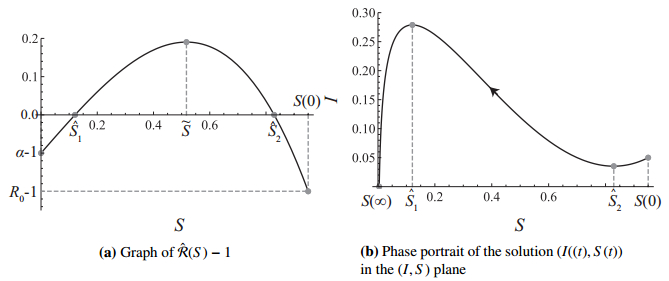









 DownLoad:
DownLoad:

